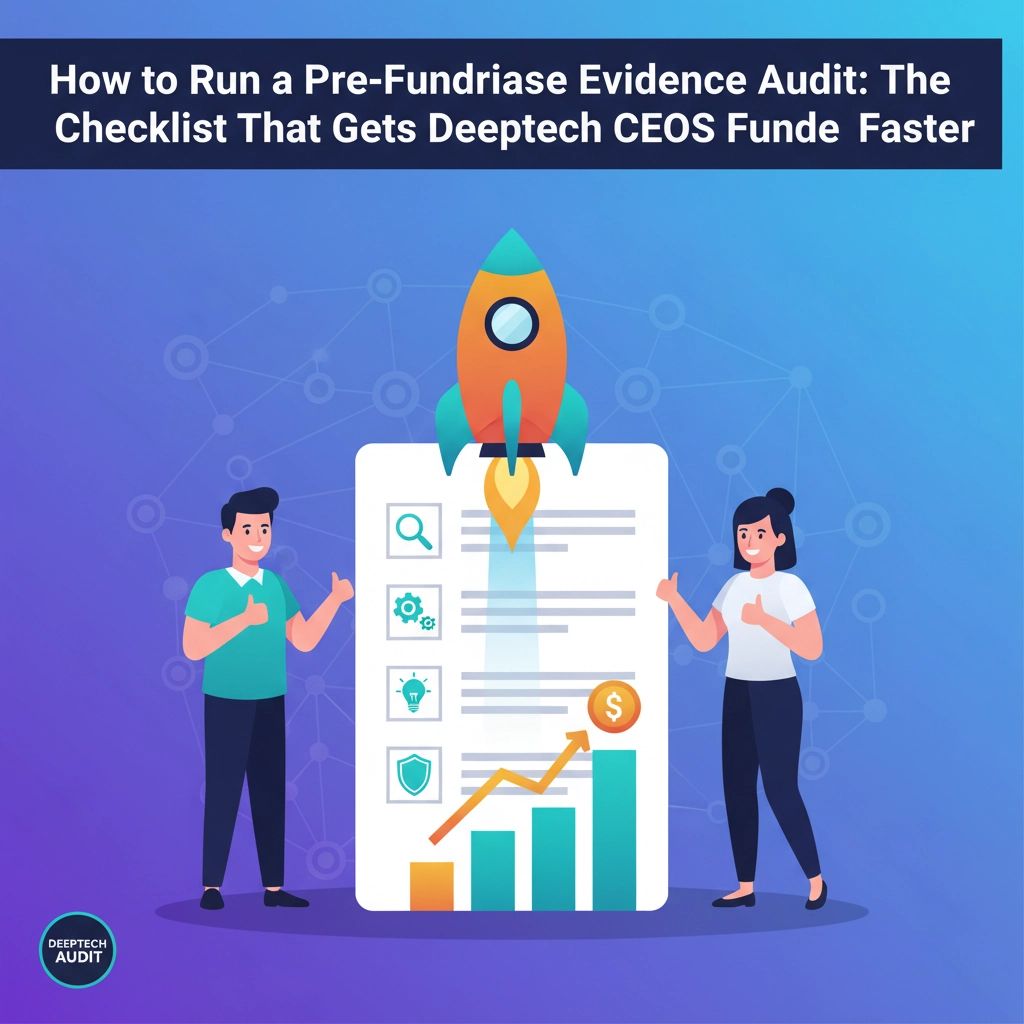How to Run a Pre-Fundraise Evidence Audit: The Checklist That Gets Deeptech/Healthtech CEOs Funded Faster
Oct 21, 2025
Last week, we talked about how evidence loops turn learning velocity into fundraising momentum. But here's the thing: all those beautiful evidence loops mean nothing if you can't present them clearly when investors come knocking.
Think of a pre-fundraise evidence audit as your dress rehearsal. You're not just checking boxes; you're stress-testing your story before it matters most. For deeptech and healthtech CEOs, this isn't optional: it's survival.
Why? Because when you're dealing with complex tech, regulatory hurdles, and long development cycles, investors dig deeper. They ask harder questions. And if you're scrambling to find that crucial IP document or can't explain your regulatory pathway clearly, you've already lost momentum.
The good news? Most of your competitors won't do this work properly. That makes a thorough evidence audit your secret weapon.
The Financial Foundation Audit
Start here because everything else builds on your financial story. Investors will judge your operational discipline before they even look at your technology.
Month 1 Checklist:
- Gather 24 months of complete financial statements (or since inception if younger)
- Reconcile every account: no exceptions
- Document your burn rate trends and runway calculations
- Create a clear cap table showing all equity holders and option pools
- Build 3-5 year projections with detailed assumptions
For healthtech startups, include R&D spend breakdowns and regulatory cost projections. Deeptech companies should model scaling costs and manufacturing capital requirements.
Red flags to eliminate:
- Missing months in your financial records
- Unexplained variances between cash flow and bank statements
- Vague or overly optimistic revenue projections
- Unclear equity ownership or missing shareholder agreements
The startups that move fastest through due diligence have financials so clean that investors spend five minutes reviewing them instead of five hours asking clarification questions.

Technical Validation Evidence
This is where deeptech and healthtech companies separate themselves from traditional software startups. Your technical evidence needs to tell a story of de-risking and progress.
Technical Documentation Audit:
- Compile all intellectual property (patents filed, pending, granted)
- Organize laboratory results and validation data chronologically
- Document third-party validation studies or partnerships
- Create technology roadmaps showing key milestones achieved and upcoming
- Prepare regulatory status reports (for healthtech) or compliance documentation
For healthtech, this means FDA correspondence, clinical trial protocols, and safety data. Deeptech companies should focus on performance benchmarks, scalability testing, and manufacturing feasibility studies.
Pro tip: Create a simple one-page technical progress timeline. Investors want to see momentum and systematic risk reduction over time.
Market Position and Traction Proof
Evidence loops from your newsletter work pay off here. All that systematic learning about customers, competition, and market dynamics becomes your traction story.
Market Evidence Checklist:
- Customer discovery interview summaries and key insights
- Letters of intent or pilot agreements from potential customers
- Competitive analysis showing your differentiation clearly
- Market sizing data with bottom-up calculations
- Unit economics modeling (even if pre-revenue)
Healthtech companies should emphasize clinical need validation and reimbursement pathway research. Deeptech startups need to prove scalability economics and manufacturing cost structures.
The key is connecting dots between customer feedback, product development decisions, and business model evolution. Investors want to see that you're building something people actually want, not just something technically impressive.

Legal and Compliance Structure
Nothing kills fundraising momentum like discovering legal issues mid-process. Clean up your corporate housekeeping before you need it.
Legal Documentation Audit:
- Corporate formation documents and bylaws
- Board meeting minutes for the past 24 months
- All employment agreements and contractor arrangements
- IP assignment agreements from employees and advisors
- Any licensing agreements or strategic partnerships
For regulated industries (most healthtech, some deeptech), add regulatory compliance documentation, ongoing applications, and legal risk assessments.
Critical point: If you discover issues, fix them or prepare clear explanations with mitigation plans. Investors can handle known problems with solutions; they can't handle surprises.
Team and Advisory Validation
Investors bet on people, especially in technical fields where execution complexity is high. Your team evidence needs to prove capability and commitment.
Team Documentation:
- Resumes highlighting relevant experience for key team members
- Advisory board agreements and advisor backgrounds
- Organizational charts showing reporting relationships
- Equity agreements and vesting schedules
- Reference contacts for key hires
For deeptech and healthtech, domain expertise matters enormously. Highlight scientific advisors, industry veterans, and regulatory experience within your extended team.

Strategic Data Room Organization
Don't just collect documents: organize them strategically. Create a virtual data room structure that tells your story while making due diligence efficient.
Folder Structure Template:
- Company Overview (pitch deck, executive summary, company timeline)
- Financials (statements, projections, cap table)
- Technology & IP (patents, technical validation, roadmaps)
- Market & Customers (research, traction, competitive analysis)
- Legal & Corporate (formation docs, contracts, compliance)
- Team & HR (org chart, key resumes, employment agreements)
Version control everything and restrict access appropriately. Investors appreciate security consciousness, especially for technical IP.
The 90-Day Implementation Timeline
Days 1-30: Foundation Building
Focus on financial cleanup and basic corporate housekeeping. Fix any gaps in financial records and gather missing legal documents.
Days 31-60: Technical Story Development
Organize IP documentation and technical validation evidence. Create clear progress timelines and risk mitigation narratives.
Days 61-90: Market Position and Polish
Finalize traction evidence and competitive positioning. Set up your data room and conduct internal dry runs with advisors.
Pro tip: Test your data room with a friendly investor or advisor before your real fundraise. They'll spot gaps you missed and suggest improvements.
Making This a Competitive Advantage
Remember, most founders approach fundraising reactively: gathering documents as investors request them. By being proactive, you flip the script.
When investors ask for information and you can provide it immediately, you signal operational excellence. When your documentation tells a clear story instead of requiring interpretation, you reduce investor workload. When you proactively address potential concerns, you build confidence.
This isn't just about avoiding delays. It's about positioning yourself as the kind of founder investors want to back: organized, transparent, and execution-focused.
The evidence loops from our previous discussion create the content for your audit. This systematic approach to organizing and presenting that evidence turns learning velocity into fundraising velocity.
Your technical complexity as a deeptech or healthtech founder is already an advantage. Adding operational discipline to the mix makes you nearly unstoppable.
Ready to build the systems that turn your evidence into fundraising momentum? Join Capital Catalyst and learn the frameworks that help technical founders raise capital faster and more efficiently.